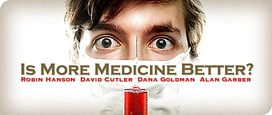David, Alan, and Dana’s first comments focused on how to better promote helpful over harmful medicine, and I tried to steer them back to the effect of simple crude cuts. But on this our last discussion day, let me address this quality issue, by describing a completely supply-based approach to Medicare quality.
Imagine each person has a health plan responsible for paying all his medical expenses. (Each person still pays his non-medical expenses, like for diet or exercise.) Each year, the government pays his health plan a dollar amount based on his quality of life figure for that year. This might be $100,000 if he is healthy, $50,000 if he is disabled, $30,000 if he is in great pain, and so on. These health evaluations are based on random visits.
Since these payments usually far exceed medical expenses, an auction is used to assign health plans. The plan willing to pay the government the most gets the (tradable) right to be that person’s health plan forever more. A full record of his medical history is made available to auction bidders.
In this scenario net payments from the government equal expected medical spending. Each health plan would have an ideal supply-based incentive to trade medical spending for quality and quantity of life gains, at least for gains reflected in official quality of life payment schedules. Plans would also have ideal incentives to advise each person on health choices, and people have little reason to distrust such advice. The government would acquire a financial incentive to hurt health, but public monitoring could prevent them from acting on such incentives.
Employer-provided medical coverage could use a similar mechanism, if a distant third party, unable to harm employee health, was paid up front to become responsible for making annual payments to health plans. Employers might adjust value of life figures to employee details, and might allow employees to contribute to raise those figures.

